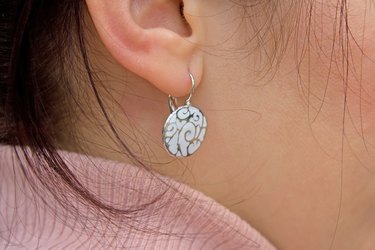
The chance of getting an infection in an ear piercing is reduced by researching the method of piercing and the piercer. An ear piercing performed in a licensed, professional body-piercing shop ensures sterile instruments and a piercer with an educational background in anatomy. A professional body piercer chooses jewelry based on the thickness and length of a client's earlobe, while allowing room for swelling. Following the after-care instructions for cleaning the ear piercing is important to avoid irritation and infection.
Allergic Reactions
Video of the Day

An allergic reaction to jewelry is possible when inappropriate jewelry is worn in an ear piercing. Avoid purchasing jewelry from websites and any store that is not a professional piercing shop. Sharing jewelry with friends or family members can cause a reaction if the original owner is not aware of the metal's properties. Symptoms of an allergic reaction include the hole of the piercing increasing in size or a rash forming around the piercing. Small red bumps, similar to acne, may form underneath the piercing if allergic to an ingredient used in after care.
Video of the Day
Bacterial Infections

Performing the piercing yourself or having a friend perform the piercing leads to infection. Tools and needles are only rendered sterile if cleaned in an autoclave. Boiling or wiping needles and equipment with alcohol or bleach does not render the equipment sterile. Bacterial infections, such as staphylococci, are possible in an ear piercing from dirty equipment or disregard for the care of an ear piercing. Not cleaning the piercing, allowing saliva onto the piercing and touching the piercing with dirty hands are ways to contract an infection. The ear piercing will have excessive swelling and exude fluids containing an unpleasant odor to indicate an infection. Red streaks from the ear piercing are also indicators of an infection.
Abscess

Abscess occurs in the ear piercing when an infection is trapped in the ear. Common reasons for abscess include removing the jewelry when an infection is present and wearing jewelry in the piercing that is too short to allow for exuding of fluids and swelling. Removing the jewelry during an infection causes the ear piercing hole to close and trapps the infection inside the ear. Do not remove the jewelry until draining the infection completely to avoid an abscess. A piercing from an establishment that uses the same length of jewelry on each client regardless of the anatomy leads to abscess. A client with thick earlobes may swell over short jewelry and encounter trapped fluids inside the ear piercing, causing an abscess. Choosing a piercer who investigates ear anatomy on each individual and provides appropriate jewelry helps avoid this issue.